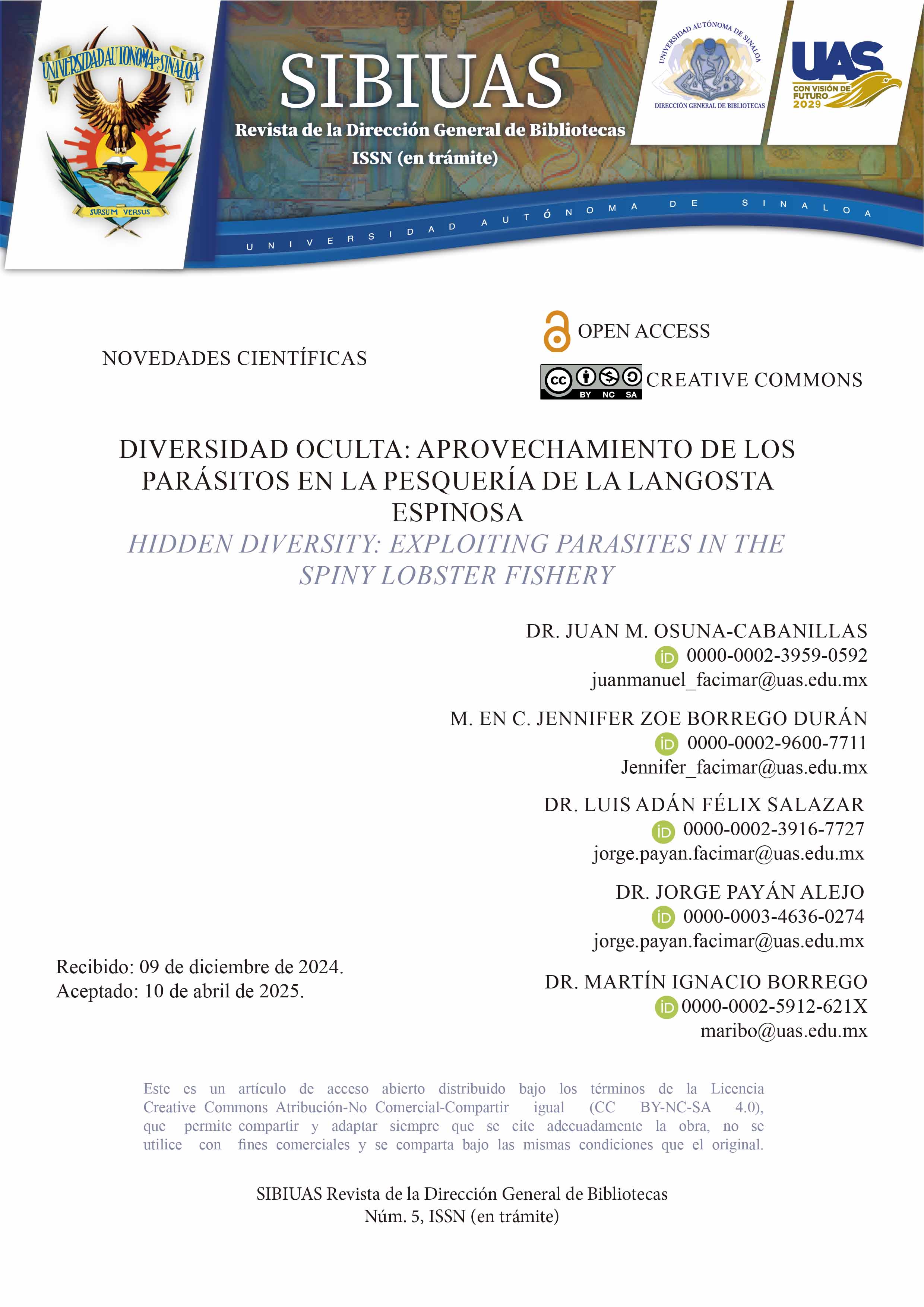Hidden diversity: exploiting parasites in the spiny lobster fisheryHidden diversity: exploiting parasites in the spiny lobster fishery
Keywords:
Sustainability, Barnacles, Spiny lobster, Gulf of California, CrustaceansAbstract
Parasites can cause devastating diseases, such as malaria, and are therefore commonly regarded as undesirable organisms with negative impacts. However, they often play a key role as ecological regulators. With their frequently complex life cycles, parasitism represents one of the most successful life strategies on the planet, as parasites are capable of infecting a wide range of hosts, from species of low commercial value to those of significant economic importance. A clear example of this can be seen in spiny lobsters, a high-value fishery resource currently being exploited at its maximum sustainable yield. These lobsters harbour a variety of parasites, such as barnacles, whose presence can provide valuable information for fisheries. As many parasites are specific to particular geographical regions, they can serve as effective biological tags for identifying distinct fish stocks. However, to utilise them effectively in fisheries management, it is crucial to understand their diversity and distribution within lobster populations. Integrating parasitological studies into conservation strategies is essential to ensure the long-term health and sustainability of the spiny lobster fishery in Sinaloa.
Downloads
References
Atherley, N. A. M., Freeman, M. A., & Dennis, M. M. (2020). Post-mortem examination of the Caribbean spiny lobster (Panulirus argus, Latreille 1804) and common pathology in a fishery of the Lesser Antilles. Journal of Invertebrate Biology, 175, 107453. https://doi.org/10.1016/j.jip.2020.107453
Borrego-Durán, J. Z. (2022). Edad y crecimiento en langosta Panulirus gracilis (Crustacea: Decapoda) por medio de estructuras calcificadas [Tesis de maestría, Universidad Autónoma de Sinaloa, Facultad de Ciencias del Mar].
Briones‐Fourzán, P., & Lozano‐Álvarez, E. (2013). Essential habitats for Panulirus spiny lobsters. In B. F. Phillips (Ed.), Lobsters: Biology, management, aquaculture and fisheries (2nd ed., pp. 186–220). Wiley-Blackwell.
Comisión Nacional de Acuacultura y Pesca (CONAPESCA). (2021). Anuario estadístico de acuacultura y pesca 2021. Secretaría de Agricultura y Desarrollo Rural. https://www.gob.mx/conapesca
Cruz, T., Fernandes, J.N., Van Syoc, R.J. y Newman, W.A. (2015). Órdenes Lepadiformes, Scalpelliformes, Verruciformes y Balaniformes. Ibero Diversidad Entomológica @ccesible, 99ª, 1-13.
Dobson, A., Lafferty, K. D., Kuris, A. M., Hechinger, R. F., & Jetz, W. (2008). Homage to Linnaeus: How many parasites? How many hosts? Proceedings of the National Academy of Sciences of the United States of America, 105(Supplement 1), 11482–11489. https://doi.org/10.1073/pnas.0803232105
Diario Oficial de la Federación (DOF). (2023). Norma Oficial Mexicana NOM-006-SAG/PESC-2023, Para regular el aprovechamiento de todas las especies de langosta en las aguas de jurisdicción federal del Golfo de México y Mar Caribe, así como del Océano Pacífico incluyendo el Golfo de California. https://www.dof.gob.mx
Gracia, A., & Kensler, C. B. (1980). Las langostas de México: su biología y pesquería. Anales del Centro de Ciencias del Mar y Limnología, Universidad Nacional Autónoma de México, 7, 111–128.
Kaishian, P., Lubbers, M., Ben Fekih, I., Goot, M. D. D., Schilthuizen, M., & Haelewaters, D. (2022). Definitions of parasites and pathogens through time. Authorea. https://doi.org/10.22541/au.164884736.54151259/v1
López-Moreno, D. G., Vallarta-Zárate, J. R. F., Marín-Enríquez, E., Amezcua, F., & Morales-Serna, F. N. (2023). Looking for parasites as potential biological tags for Pacific thread herring, Opisthonema libertate (Günther, 1867) (Clupeiformes, Dorosomatidae), in the Gulf of California. Fishes, 8(7), Article 336. https://doi.org/10.3390/fishes8070336
Marcogliese, D. J. (2005). Parasites of the superorganism: Are they indicators of ecosystem health? International Journal for Parasitology, 35(7), 705–716. https://doi.org/10.1016/j.ijpara.2005.01.015
Osuna-Cabanillas, J. M., & Morales-Serna, F. N. (2023). La misión de los parásitos en nuestro planeta. Ecofronteras, 27, 12–16.
Poulin, R., & Morand, S. (2000). Parasite biodiversity. The Quarterly Review of Biology, 75(3), 277–293. https://doi.org/10.1086/393500
Ramírez-Félix, E. A., Villa-Diharce, E. R., García-Borbón, J. A., & Cisneros-Mata, M. A. (2024). Life cycle and natural mortality rates of the blue spiny lobster (Panulirus inflatus). Fisheries Research. (En prensa)
Sures, B., Nachev, M., Schwelm, J., Grabner, D., & Selbach, C. (2023). Environmental parasitology: Stressor effects on aquatic parasites. Trends in Parasitology, 39(6), 461–474. https://doi.org/10.1016/j.pt.2023.03.001
Van Der Lingen, C. D., Weston, F. L., Ssempa, N. N., & Reed, C. C. (2014). Incorporating parasite data in population structure studies of South African sardine Sardinops sagax. Parasitology, 142(1), 156–167. https://doi.org/10.1017/S0031182014000586

Downloads
Published
Issue
Section
Categories
License
Copyright (c) 2025 SIBIUAS Revista de la Dirección General de Bibliotecas

This work is licensed under a Creative Commons Attribution-NoDerivatives 4.0 International License.

